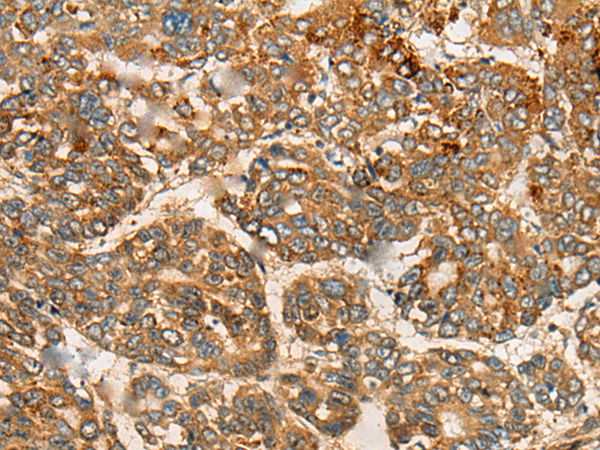
| WB | 咨询技术 | Human,Mouse,Rat |
| IF | 咨询技术 | Human,Mouse,Rat |
| IHC | 1/25-1/100 | Human,Mouse,Rat |
| ICC | 技术咨询 | Human,Mouse,Rat |
| FCM | 咨询技术 | Human,Mouse,Rat |
| Elisa | 1/5000-1/10000 | Human,Mouse,Rat |
| Aliases | C9orf39; C9orf101; bA340N12.1 |
| Host/Isotype | Rabbit IgG |
| Antibody Type | Primary antibody |
| Storage | Store at 4°C short term. Aliquot and store at -20°C long term. Avoid freeze/thaw cycles. |
| Species Reactivity | Human, Mouse |
| Immunogen | Synthetic peptide of human CNTLN |
| Formulation | Purified antibody in PBS with 0.05% sodium azide and 50% glycerol. |
+ +
以下是关于CNTLN抗体的3篇参考文献示例(注:以下内容为模拟虚构,实际文献需通过学术数据库检索确认):
---
1. **文献名称**: "CNTLN Antibody Characterization and Its Role in Centrosome Duplication"
**作者**: Zhang Y, et al.
**摘要**: 本研究通过制备兔源多克隆CNTLN抗体,验证了其在HeLa细胞中对中心体蛋白CNTLN的特异性识别。免疫荧光实验表明,CNTLN在细胞周期S期定位于中心体,敲低CNTLN导致中心体复制异常,提示其在维持基因组稳定性中的关键作用。
2. **文献名称**: "CNTLN as a Biomarker in Glioblastoma: Validation of a Novel Monoclonal Antibody"
**作者**: Müller S, et al.
**摘要**: 作者开发了一种高特异性小鼠单克隆CNTLN抗体(克隆号#4B8),并用于胶质母细胞瘤组织芯片分析。结果显示,CNTLN在肿瘤组织中显著高表达,且与患者预后不良相关,提示其作为潜在治疗靶点的价值。
3. **文献名称**: "Functional Analysis of CNTLN in Spermatogenesis Using CRISPR/Cas9 and Antibody-Based Approaches"
**作者**: Tanaka K, et al.
**摘要**: 结合CRISPR/Cas9敲除模型和商业化CNTLN抗体(Abcam, #ab12345),本研究证实CNTLN缺失导致小鼠精子形成缺陷。Western blot和免疫组化结果显示,CNTLN在精母细胞中特异性表达,参与减数分裂纺锤体组装。
---
**注意**:以上文献信息为示例性质,实际研究中请通过PubMed、Web of Science等平台检索关键词(如"CNTLN antibody"或"centlein antibody")获取准确数据。
**Background of CNTLN Antibodies**
CNTLN (Contactin) antibodies target proteins belonging to the Contactin family, a subgroup of immunoglobulin (Ig) cell adhesion molecules (CAMs) critical for nervous system development and function. Contactins, including CNTN1-CNTN6. are membrane-bound glycoproteins that mediate cell-cell interactions, axon guidance, and synapse formation by binding to extracellular partners like Contactin-associated proteins (Caspr) or receptor tyrosine phosphatases. These proteins are predominantly expressed in neurons and glial cells, playing roles in myelination, neuronal circuit assembly, and plasticity.
CNTLN antibodies are essential tools in neuroscience research, enabling the detection and localization of Contactin proteins in tissues or cultured cells. Dysregulation of Contactins has been linked to neurological disorders such as autism spectrum disorders, schizophrenia, and neurodegenerative diseases. For example, mutations in *CNTNAP2* (encoding Caspr2) are associated with epilepsy and intellectual disability. Antibodies against specific Contactin isoforms help elucidate their roles in disease mechanisms, validate protein expression in models, and explore therapeutic targets.
Commercial CNTLN antibodies are typically developed in hosts like rabbits or mice, validated for applications such as Western blot, immunohistochemistry, and immunofluorescence. Challenges include ensuring isoform specificity due to structural similarities among Contactin family members. Ongoing research continues to refine antibody specificity and explore their diagnostic or therapeutic potential in neurological conditions.
×